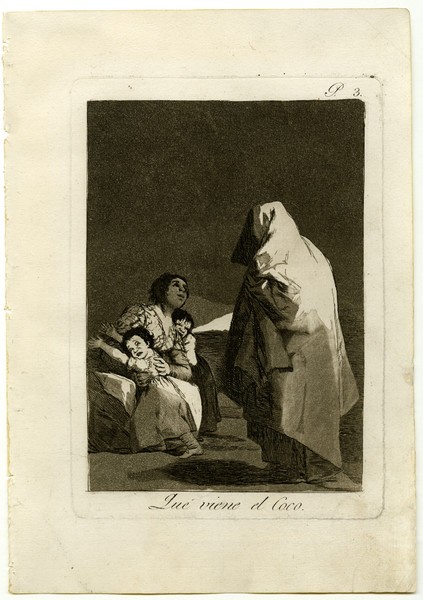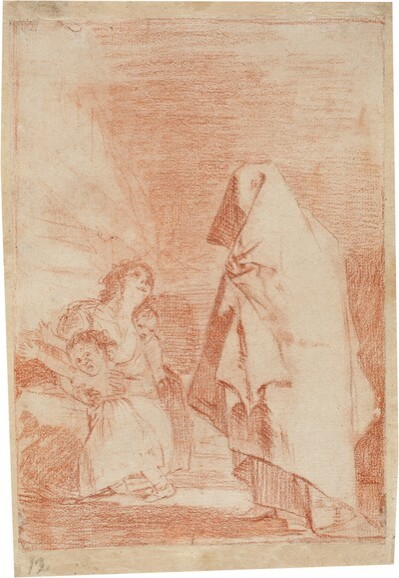- Cronología
- Ca. 1797 - 1799
- Dimensiones
- 219 x 154 mm
- Técnica y soporte
- Etching and burnished aquatint
- Reconocimiento de la autoría de Goya
- Undisputed work
- Ficha: realización/revisión
- 10 Nov 2010 / 29 May 2024
- Inventario
- 225
Que viene el Coco (at the bottom).
P.3. (in the upper right corner)
See Francisco de Goya y Lucientes, Painter.
There are several state proofs, none of which is prior to the aquatint. One of them has the title and numbering written in black pencil. In the title, the b for "viene" is crossed out and replaced by a v, as confusion between b and v was very common at the time, which led to the copper engraving with a b.
A preparatory drawing for this engraving is in the Prado Museum.
In the centre of the print, slightly shifted to the right, we can see a figure completely covered in a tunic looking at a seated mother holding her two children. One of them raises his arms and seems to want to flee in terror, while the other clings to the mother figure in search of protection.
Goya used aquatint for the background and etching to create the folds in the tunic of the figure who is frightening the children, as well as the mother and the children.
In the manuscripts on the meaning of The Caprices, several clarifications are made about the meaning of this print. The one in the Prado Museum states that this work "represents the disastrous abuse of early education. Making a child more afraid of the Coco than of his father and forcing him to fear what does not exist". The Ayala manuscript notes that Goya depicted how "mothers frighten their children with the Coco to talk to their lovers", while the National Library manuscript states that "foolish mothers make children fearful by depicting the Coco; and others worse use this artifice to be alone with their lovers when they cannot keep their children away from them".
The bogeyman was a figure used to reprimand and frighten children when they did not behave properly. In a 17th-century song that alludes to this figure, whose morphology is unknown to us, the following is said: "Duerma y sosiegue/ que a la fe que venga el coco/ si no se duerme" ("Sleep and be calm/ that the bogeyman will come to faith/ if he does not sleep"). In this image, the Aragonese painter, from the perspective of an enlightened man, emphasises the importance of education and the need for children to grow up free of superstition and ghosts.
At the same time, this work admits a second reading that would have to do with the criminals who took advantage of the superstitions of the people to commit their misdeeds by entering houses at night, disguised as spectral beings. This is explained by Fray Benito Jerónimo Feijóo (Casdemiro, Pereiro de Aguiar, 1676-Oviedo, 1764) who in his work Theatro crítico universal (1726-1739) says the following: "(...) O quantos hurtos, quantos estrupos, y adulterios se han cometido, cubriendo, ó los agresores, ó los medianeros con la capa de Duendes! These heavy mockeries were stopped, or stopped whenever in the house where they took place, there was a man of spirit, who intrepidly endeavoured to examine the truth. Where the whole family is made up of easily credulous people, deceit is sure to triumph, unless some accident reveals it".
To capture this world of the unreal, Goya may have drawn on images by the painter Salvator Rosa (Naples 1620-Rome, 1673), whose work he was probably familiar with during his stay in Italy (1769-1771), when he was still a budding artist. The haunting figure in Goya's engraving recalls the protagonist of Rosa's painting The Shadow of Samuel Appears to Saul (1668, Musée du Louvre, Paris). Furthermore, the appropriate treatment of the panneggio by which Goya has succeeded in giving corporeality to the canvases in which the anatomy is concealed is related to the figures that Charon is carrying in his boat as he crosses the Stygian Lagoon in the work by Pierre Subleyras (Saint-Gilles-du-Gard, 1699- Rome, 1749) entitled Charon carrying the shadows (ca. 1735, Musée du Louvre, Paris).
The theme of education was again addressed in prints no. 4, The rollona, and no. 25, The Pitcher Broke from the series of The Caprices.
This engraving aroused the interest of Eugène Delacroix (Charenton-Saint-Maurice, 1798-Paris, 1836), who copied it using the aquatint technique (ca. 1830, Bibliothèque Nationale de France, Paris).
The plate is preserved in the National Chalcography (no. 174).
-
Goya. Gemälde Zeichnungen. Graphik. TapisserienKunsthalle BaselBasle1953from January 23th to April 12th 1953cat. 195
-
De grafiek van GoyaRijksmuseum RijksprentenkabinetAmsterdam1970from November 13th 1970 to January 17th 1971cat. 14
-
El arte de GoyaMuseo de Arte Occidental de TokioTokyo1971from 16th 1971 to January 23th 1972. Exhibited also at the Kyoto Municipal Museum of Art, January 29th to March 15th 1972.cat. 54
-
Goya. Das Zeitalter der Revolucionen. Kunst um 1800 (1980 – 1981)Hamburger KunsthalleHamburg1980cat.42
-
Goya dans les collections suissesFundación Pierre GianaddaMartigny1982consultant editor Pierre Gassier. From June 12th to August 29th 1982cat. 43
-
Goya y el espíritu de la IlustraciónMuseo Nacional del PradoMadrid1988from October 6th to December 18th 1988. Exhibited also at Museum of Fine Arts, Boston, January 18th to March 26th 1989; The Metropolitan Museum of Art, Nueva York, May 9th to July 16th 1989, Madrid curator Manuela B. Mena Marqués, scientific directors Alfonso E. Pérez Sánchez and Eleanor A. Sayrecat.40
-
Goya. La década de Los CaprichosMadrid1992organized by Real Academia de Bellas Artes de San Fernando sponsored by Fundación Central Hispano, Madrid, consultant editor Nigel Glendinnig. From October 26th 1992 to January 10th 1993cat. 44
-
Francisco de GoyaMuseo d'Arte ModernaLugano1996exhibition celebrated from September 22nd to November 17th.cat. 3, p.30
-
Ydioma universal: Goya en la Biblioteca NacionalBiblioteca NacionalMadrid1996from September 19th to December 15th 1996cat. 126
-
Francisco Goya. Sein leben im spiegel der graphik. Fuendetodos 1746-1828 Bordeaux. 1746-1996Galerie KornfeldBern1996from November 21st 1996 to January 1997cat. 9
-
Francisco Goya. Capricci, follie e disastri della guerraSan Donato Milanese2000Opere grafiche della Fondazione Antonio Mazzottacat. 3, p.17
-
Goya e la tradizione italianaFondazione Magnani RoccaMamiano di Traversetolo (Parma)2006consultant editors Fred Licht and Simona Tosini Pizzetti. From September 9th to December 3th 2006cat. 3, p.146
-
Goya. Opera graficaPinacoteca del Castello di San GiorgioLegnano2006exhibition celebrated from December 16th 2006 to April 1st 2007p.22
-
Goya e ItaliaMuseo de ZaragozaZaragoza2008organized by the Fundación Goya en Aragóna, consultant editor Joan Sureda Pons. From June 1st to September 15th 2008cat. 318
-
Goya et la modernitéPinacothèque de ParisParís2013from October 11st 2013 to March 16th 2014cat. 139
-
Agen2019cat. 49
-
2022
-
Goya engravings and lithographs, vol. I y II.OxfordBruno Cassirer1964cat. 38, p.73
-
Vie et ouvre de Francisco de GoyaParísOffice du livre1970p.176, cat. 455
-
La década de los Caprichos. Retratos 1792-1804MadridReal Academia de Bellas Artes de San Fernando1992cat. 44-45, pp.74-76
-
Goya. El capricho y la invención. Cuadros de gabinete, bocetos y miniaturasMadridMuseo del Prado1993p.47, fig. 23
-
Catálogo de las estampas de Goya en la Biblioteca NacionalMadridMinisterio de Educación y Cultura, Biblioteca Nacional1996cat. 90-91, pp.74-75
-
El libro de los caprichos: dos siglos de interpretaciones (1799-1999). Catálogo de los dibujos, pruebas de estado, láminas de cobre y estampas de la primera ediciónMadridMuseo Nacional del Prado1999pp.68-71
-
Francisco Goya. Los CaprichosBarcelonaEdiciones de la Central2011p.42
-
ParísPinacoteca de París2013p. 201
-
Goya. In the Norton Simon MuseumPasadenaNorton Simon Museum2016pp. 42-75
-
AgenSnoeck2019p. 142
-
Museo de Bellas Artes de Badajoz y Diputación de Badajoz2022p. 29

